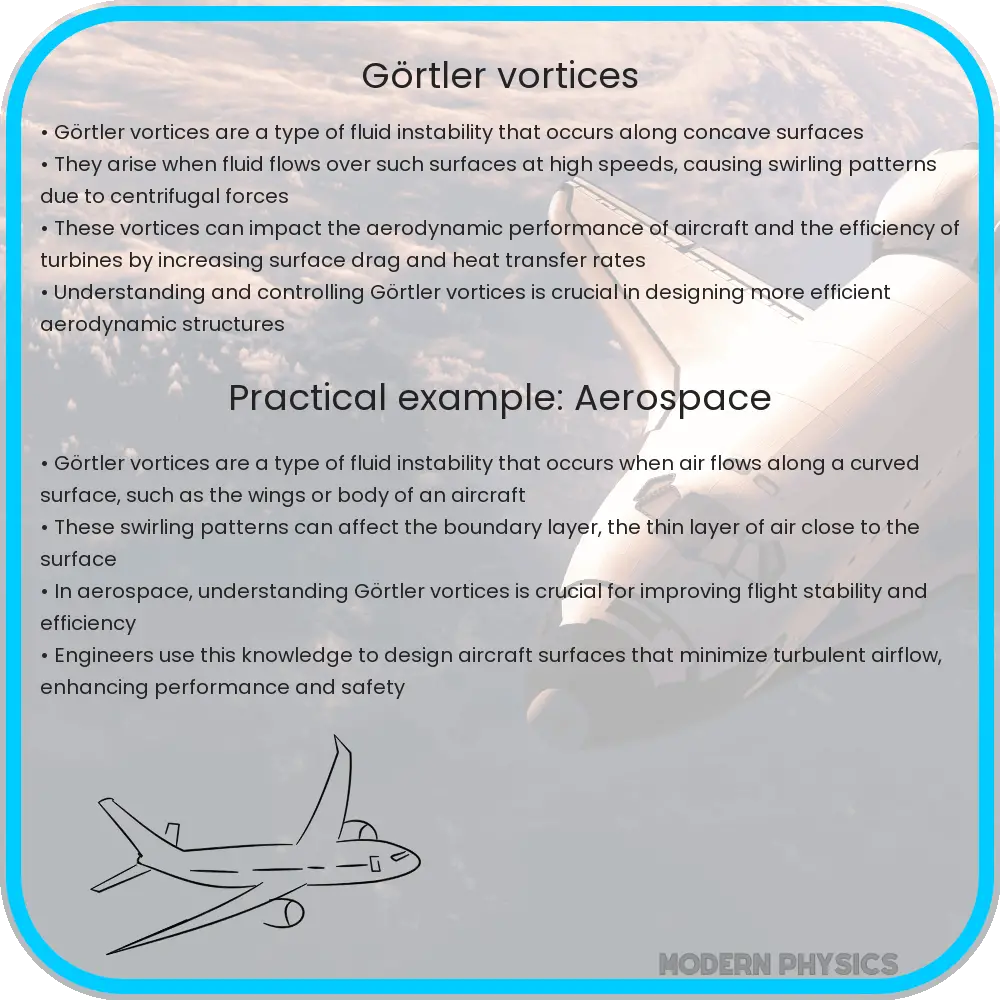Explore Görtler Vortices in fluid dynamics: their formation, impact on flow, stability analysis, and applications in engineering and technology.

Understanding Görtler Vortices in Fluid Dynamics
Görtler vortices are a fundamental phenomenon in fluid dynamics, particularly relevant in the context of boundary layer flow over curved surfaces. These vortices are named after the German physicist Henry Görtler, who first described them in the mid-20th century. They are a type of secondary flow that occurs when a viscous fluid flows along a concave wall, leading to the development of coherent streamwise vortices. Understanding Görtler vortices is crucial for a wide range of applications, from aerospace engineering to the design of efficient pipeline systems.
Formation and Characteristics
The formation of Görtler vortices is primarily due to the centrifugal instability. When fluid particles move along a curved surface, the centrifugal force pushes them away from the center of curvature. This force is balanced by the pressure gradient in the boundary layer. However, when certain conditions are met, such as a sufficiently high curvature of the wall or a high enough Reynolds number (Re), this balance is disrupted, leading to the rolling up of the boundary layer into vortices.
The Reynolds number, a dimensionless quantity in fluid mechanics, is defined as Re = ρuL/μ, where ρ is the fluid density, u is the velocity, L is a characteristic length, and μ is the dynamic viscosity of the fluid. The critical Reynolds number at which Görtler vortices form depends on the curvature of the surface and the properties of the fluid.
Stability Analysis
Stability analysis of Görtler vortices involves examining the conditions under which these vortices amplify or decay. Linear stability theory is often employed to determine the onset of vortex formation. This theory considers small perturbations to the flow and analyzes their growth or decay over time. Non-linear effects, however, play a significant role in the further development and saturation of these vortices.
One key aspect of Görtler vortices is their wavelength, which is a measure of the distance between adjacent vortices. The wavelength is influenced by factors such as the Reynolds number and the curvature of the surface. Smaller wavelengths are generally associated with higher Reynolds numbers.
Impact on Flow Dynamics
Görtler vortices can significantly impact the overall flow dynamics. They can enhance heat and mass transfer due to the increased mixing in the boundary layer. However, they can also lead to increased skin friction drag and potential flow separation, which are critical considerations in aerodynamic design. In industrial applications, such as in heat exchangers or pipelines, understanding and controlling these vortices can improve efficiency and reduce operational issues.
In summary, Görtler vortices represent an intriguing and complex aspect of fluid dynamics. Their study not only advances our understanding of flow physics but also aids in the optimization of various engineering systems where fluid flow over curved surfaces is a key factor.
Advanced Studies and Applications
Advanced computational fluid dynamics (CFD) simulations and experimental techniques have greatly enhanced our understanding of Görtler vortices. These tools allow researchers to visualize and analyze the intricate details of vortex formation and evolution under various conditions. Such studies have shed light on the non-linear interactions between vortices and their impact on boundary layer stability and transition to turbulence.
One of the critical areas of application is in the field of aerospace engineering. The presence of Görtler vortices on aircraft wings and fuselage can significantly affect aerodynamic performance. Understanding these vortices helps in designing more efficient and safer aircraft by minimizing drag and preventing flow separation.
Controlling Görtler Vortices
Controlling or mitigating Görtler vortices is another area of active research. Techniques such as surface modifications, including dimples or riblets, and the use of boundary layer suction have been explored. These methods aim to alter the flow characteristics near the wall to either prevent the formation of vortices or reduce their intensity.
Another approach involves the use of flow control devices like vortex generators. These small aerodynamic devices are strategically placed on the surface to influence the flow pattern, thereby managing the adverse effects of Görtler vortices.
Implications in Heat Transfer and Energy Systems
In the context of heat transfer, Görtler vortices play a dual role. While they can enhance the mixing of fluid layers, leading to improved heat transfer rates, they can also cause localized hot spots due to uneven heat distribution. This aspect is particularly crucial in designing cooling systems for electronic devices and reactors, where precise temperature control is essential.
In energy systems, especially in the design of efficient combustion chambers and heat exchangers, understanding the influence of these vortices can lead to significant improvements in performance and energy efficiency.
Conclusion
Görtler vortices, with their unique formation mechanism and significant impact on fluid flow, represent a fascinating area of study in fluid dynamics. Their relevance spans across various fields, from enhancing aerodynamic designs to improving heat transfer processes. As research continues to evolve, employing advanced simulation tools and innovative control techniques, our ability to predict, utilize, and manage these vortices will only improve. This knowledge not only contributes to our fundamental understanding of fluid behavior but also paves the way for more efficient and effective applications in engineering and technology.
